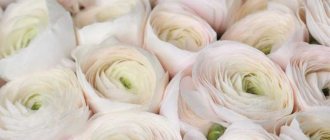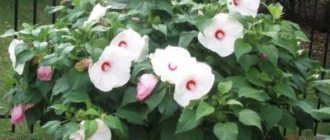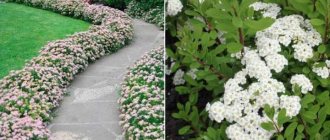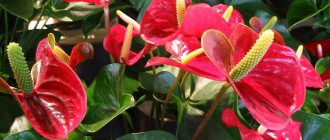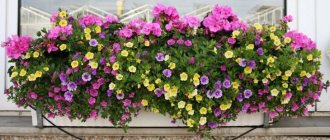Description
Pedilanthus is an ornamental, flowering shrub belonging to the Euphorbiaceae family.
Its name comes from Greece from the words shoe ("pedilon") and flower "anthos".
The leaves are light green (dark or light), wavy. They can be sessile or short-petioled, alternate, up to 8-10 cm long, smooth or slightly pubescent.
The stem is cylindrical, grayish or green in color.
The flowers are formed in dense apical inflorescences with two red, small, pointed bracts , about 2 cm in diameter. Inflorescences are pink or red. They resemble the heads of small birds or shoes.
Description of the plant
Pedilanthus belongs to the Euphorbiaceae family. This is evidenced by the release of thick white juice from the cut sites. Due to the charming appearance of the flowers, the plant also has a second name - fairy slippers. The lush inflorescence is formed by small pointed flowers , reminiscent of women's pumps.
It lives on almost the entire American continent, differing significantly in appearance depending on its proximity to the equator.
Grows as small trees in moderately humid areas.
In arid areas, the plant is leafless and looks like a cactus , as it has a thickened stem that intensively stores water.
In tropical forests with an abundance of moisture and warmth, pedilanthus shows all its beauty: branched shrubs with dense foliage and lush color.
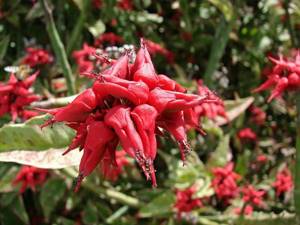
The size of plants does not exceed 3 meters in natural conditions, and indoor varieties are characterized by short stature: they reach a maximum of 1–1.5 meters in height.
The leaves are of various shapes, depending on the variety : oval or elongated, smooth or with a wavy edge. The tip is usually pointed. The leaves are attached to the stems by the base or a very short petiole.
A characteristic feature is the abundant coating of the leaf plates with wax , which even resembles an artificial composition. The color of the plant ranges from dark olive to light green, and the edges of the leaves are edged with white patterns with jagged edges.
Important! Pedilanthus is a poisonous plant due to the presence of thick and caustic juice. All work with it should be done with gloves, and if there are children and animals in the house, then you need to decide whether it is possible to keep such a flower at home and make an informed decision.
General information about the plant
The genus Pedilanthus belongs to the Euphorbiaceae family and includes 15 species, which cannot be classified into one genus in appearance, because they differ so much. There are trees, shrubs, and leafless succulents here.
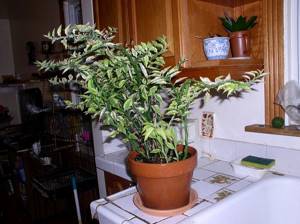
Typical pedilanthus. In the kitchen
Representatives of pedilanthus live in the Americas - central, northern and southern. Place of growth - tropical forests. But one species - pedilanthus tatimaloides - grows on the windowsill of an apartment where the climate is not tropical.
Fairy slippers or "devil's backbone"
The name of the genus comes from two Greek words “pedilon” - shoe and “anthos” - flower. Pedilanthus flowers resemble shoes, fashionable, pink, with a pointed toe. And there are up to five dozen such miniature “shoes” on the plant. It’s as if little fairies or elves took off their ballroom shoes so that their feet could rest after dancing. Colorful flowers, interesting leaves, branches, the direction of growth of which is distinguished by the highest degree of originality - pedilanthus has a chance to be accepted into the elite “club” of highly decorative indoor plants.
Interesting Facts
Native Americans called this flower by two opposite names. One – “Jacob’s Ladder” – because the plant’s stems are zigzag-shaped. And for the same stems, others called the poor pedilanthus, not involved in relations with evil spirits, “Devil's Backbone” - “Devil's Backbone”.
Pedilanthus - spurge. This means that when damaged, the leaves and stems leak a thick white sap, similar to a milky slurry.
Pedilanthus is a succulent, unpretentious in care, undemanding to its habitat. It is able to store water in its dense leaves, so the plant does not dry out easily, even with irregular watering. In the homeland of plants, drought is not uncommon. In case of emergency, milkweed sheds its leaves, delegating its functions to thick, fleshy, green, “dancing” stems.
Kinds
There are 15 different species in nature. The most common in indoor culture are:
Large-fruited
Pedilanthus macrocarpus benth..
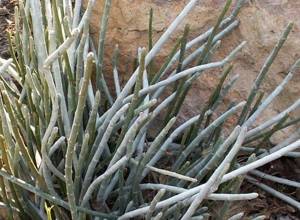
Perennial leafless succulent with bushy form . The leaves are reduced in the form of scales. Homeland: Sonora. It has round, gray-green stems that store water in dry times.
Some of the stems may change to a flattened appearance. The flowers are umbellate, red or tinged with orange .
Titimaloid
Tithymaloides (L.) Poit..
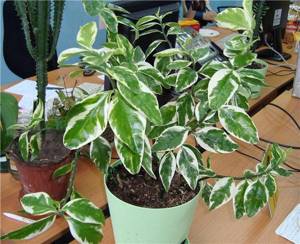
People often call it the “devil’s ridge” for the unusual feature of the stem, which changes its direction when new leaves appear. Grows up to 60-80 cm.
It is a branched, thickened shrub with a smooth, erect, fleshy, curved stem and lacent leaves that vary in color: green and white, with cream edges, pink in color.
The color depends on the conditions of possession. Red inflorescences . Subspecies ssp. smalii. It is distinguished by a more curved, zigzag stem.
Finca
Pedilanthus Finka (finkii Boiss.).
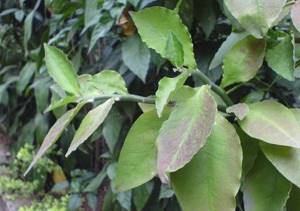
Endowed with bright, green, large leaves . Stems are zigzag, glossy, erect. In its natural environment, it is distributed in tropical rainforests of the United States. Prefers light, breathable soil.
Shportsevy
Pedilanthus calcaratus Schltdl..
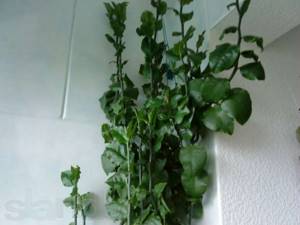
A common tree species . A very tall evergreen shrub up to three meters in height. Stems are green, dark, branching. The leaves are ovate-rounded, pointed, with wavy edges, up to 5-6 cm long.
In cool weather conditions, it may shed some leaves. The same thing happens with unfavorable home maintenance.
Types and varieties of plants, appearance
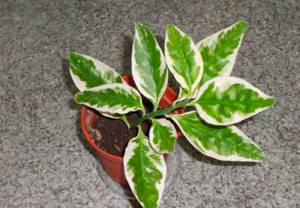
The pedilanthus plant in the wild grows in the form of bushes or trees, reaching a height of 3 m. Despite the huge number of plant species in nature, not such a large number of plants grow at home. The most common varieties in indoor cultivation are:
- Large-fruited - a succulent growing as a bush. It has an almost bare gray-green stem and scale-shaped leaves. The flowers are red (less often deep orange) collected in clusters at the tops of the shoots.
- Pedilanthus titimaloides is an ornamental shrub with strongly curved, wavy stems. Under appropriate conditions, it can grow up to 80 cm. The bright leaves with a border around the edges are very beautiful; the color of the leaves can be bright green, white, pink, or cream. Red flowers of unusual shape are collected in inflorescences of 5-7 flowers.
- Finka is a bright green tree or bush with large oval-shaped leaves and slightly curved stems.
- Koalkomanensky is a deciduous succulent with very beautiful inflorescences of peach, pink-beige, and scarlet colors; this variety is variegated.
- Shportsevy, well suited for greenhouses and greenhouses. Often reaches a considerable height (2.5-3 m). With growth, the stems become woody, the leaves become large and round in shape.
Home care
Pedilanthus requires care, attention and care.

At the same time, caring for it at home is not at all difficult and even a beginner will be able to cope with this task.
Many gardeners do not pay enough attention to care after purchase, and then face various problems .
First, the pedilanthus must be transplanted into another container.
In the store, pedilanthus flowers are kept in temporary pots, which are used for overexposure.
They are not suitable for permanent maintenance.
The soil
The soil should be loose, nutritious , and provide sufficient flow of air and moisture to the root system. Water should not stagnate so as not to provoke the development of root rot.
The best option is to purchase a ready-made mixture for succulents and cacti.
You can prepare the soil mixture yourself from grain and leaf soil in equal proportions, brick shavings, and sand.
Pot
The container is selected to match the size of the root system or slightly larger. The flower has small roots. It is better to choose clay pots. This material is more environmentally friendly.
The container must have a hole at the bottom. Be sure to add drainage to the bottom.
Transfer
Transplantation should be carried out in warm spring after the appearance of young leaves. The exception is transplantation immediately after purchase. Does not require frequent transplantation. It is carried out when the roots begin to fill the full volume of the pot.
After transplantation, it is recommended to place the pedilanthus in a dark place. This will help you adapt and relax faster.
Fertilizers
In summer and spring, the flower is fertilized once every 30 days. It is better to use special fertilizer for succulents and cacti. During dormancy you cannot feed .
Fertilizers must be nitrogen-free. It has an extremely negative impact on the health of the plant.
Lighting
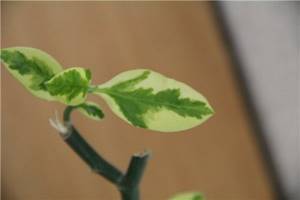
It is preferable to grow in well-lit rooms with open, bright windows.
The plant will be most comfortable on the window sills facing the southeast, southwest, and east.
If the pot is on the south side, take care to create diffused lighting. Direct sunlight is dangerous for the flower and can lead to burns.
In late autumn and winter, if there is a lack of sunlight, additional artificial lighting is recommended .
Thermal mode
The room temperature should be moderate : in summer about 20-24 degrees, and in winter no higher than 14-16.
In summer, ventilate the room more often , take the pot out into the open air so that it can breathe and bask in the sun.
In winter, protect from drafts and rare temperature changes.
Pedilanthus does not like high room temperatures and too dry air . It may get sick, the foliage may begin to fall off, and the stem may stretch forward.
Watering
In spring and summer, pedilanthus needs abundant , but not frequent watering.
The soil must dry completely before the next moistening. In winter, the plant is watered rarely (about once every 1-1.5 weeks).
A lack of moisture may be indicated by drooping leaves or their shedding.
Only settled raw water at room temperature is suitable for irrigation. In hot weather, watering needs to be increased.
Air humidity
The plant is well adapted for keeping in apartments. The air should be moderately dry .
In summer, it is recommended to spray with water to prevent the leaves from falling and turning yellow.
In winter, do not place the pot near heating devices.
Some gardeners place the pot in a tray of wet pebbles or place a container of water nearby for additional moisture (if needed).
Reproduction
How does it reproduce at home? Pedilanthus is easily propagated by cuttings .
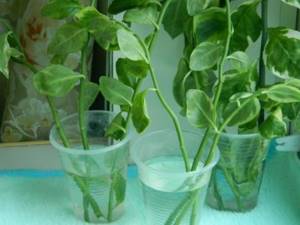
Seeds less often, since this work is troublesome and requires a lot of time and effort.
Propagation by cuttings is recommended to be carried out as follows: cut off the tops of pedilanthus shoots (8 cm in length) and dry them at room temperature for 1-2 days.
Root in dry sand at a temperature of 22-24 degrees. Before planting the cuttings, the sand is warmed up. There is no need to cover the pot with glass, so as not to provoke the appearance of rot.
Can be rooted in boiled warm water , regularly replacing with fresh water.
After rooting the cuttings, they are planted in a new place.
Bloom
Pedilanthus blooms in late autumn and early winter..
During this period, it is recommended to increase the frequency of watering and not change the location of the pot.
Trimming
Pedilanthus does not require regular pruning if it grows well and develops well.
Some gardeners prune the plant after replanting to increase branching.
A third of the branch is cut off, after which it is treated with sulfur or charcoal for quick healing.
Smell
The indoor plant does not have a pronounced odor.
Lifespan
Pedilanthus is a perennial houseplant.
With proper care, it will grow and develop every year .
In an adult plant, over the years, the lower part of the shoots may lose its decorative effect due to exposure.
What you should know before buying pedilanthus
Pedilanthus is a luxurious subshrub with randomly scattered shoots and miniature leathery leaves. Their color varies and each subspecies has its own, and can be either fresh olive, bright light green, or gradually turn into gray undertones. This exotic comes from the tropical forests of southern, northern and central America. Belongs to the family of succulents, well adapted to the environment and undemanding in terms of care.

Even with rare watering, it will survive due to its own natural thriftiness. Its dense shoots will retain the required amount of moisture, creating an excellent basis for nutrition during the dry period. Under unfavorable care conditions, the plant completely gets rid of the “green cap”. Their function is taken over by a thick, fleshy, “dancing” stem. The presence of white thick juice in it made it possible to classify the flower as a member of the Euphorbia family.
Photo
Pedilanthus care at home:
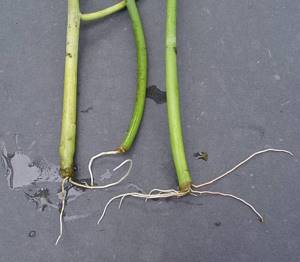
Pedilanthus flower:

Pedilanthus indoor plant:
Diseases and pests
Pedilanthus is distinguished by its stable, good immunity , which allows it to protect against pests and diseases. Problems can be caused by improper care.
A common problem is root rot (fungal disease). Associated with improper, excessive watering. The disease is insidious.
If not detected in time, it can lead to death. The flower needs to be replanted, having first washed the roots from rot, removed the damaged parts and treated them in a weak solution of potassium permanganate.
It is recommended to disinfect new soil and containers before planting.
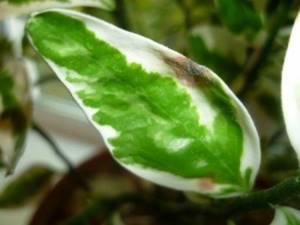
If the plant is in a hot room with very dry air, it can be attacked by spider mites and aphids. Treatment with a soap solution or Actellik solution will help get rid of pests.
When infected with whitefly, the leaves begin to turn yellow and stick to the skin of the hands when touched. Insecticide treatment is very effective against pests.
When affected by a mealyworm, cotton wool -like fluff appears in the axils of the leaves and on the stems, and the plant stops growing. It is necessary to remove the pest with a cotton alcohol swab.
Note to the florist:
- If your pedilanthus is dropping its leaves , you may be keeping it in cold, drafty conditions.
Pay attention to the condition of the stems. Frozen, dead parts need to be cut off. New shoots will appear in their place. - the stem begins to stretch in late autumn or winter , you need to reduce the air temperature in the room and also pay attention to the lighting.
It is possible that the flower needs more light. - If the flower has not bloomed , pay attention to care during the dormant period.
- Yellowing and drying of leaves in summer indicate a lack of watering.
Do not leave the pot on the windowsill without shade in hot weather to prevent overheating and burns.
Pests, diseases and other problems in caring for the Pedilanthus flower
The plant is most often affected by mealybugs, whiteflies, and aphids. If the leaves become dull, the plant may be attacked by spider mites. Treat mild infestations by removing heavily infested leaves and spraying the plant with insecticidal soap and acaricides.
If white insects are found on the plant, and its leaves begin to turn yellow and stick together when touched, then the flower is attacked by a whitefly. If a warm shower does not help, you can resort to using an insecticide.
Aphids often attack the leaves of the plant. They curl up and stop growing. This pest can be controlled with a stream of warm water and an insecticide treatment.
Scale insects are common pests that you should also be concerned about. They look like small bumps on the leaves. Wipe them with cotton swabs soaked in alcohol.
As for diseases, the houseplant Pedilanthus is susceptible to powdery mildew and fungal disease. Fungal infection of the plant causes the stems to begin to rot. The only method of control is to remove the affected parts.
What are the problems with growing Pedilanthus?
Let us list the most common unpleasant situations that arise when growing a flower.
- The tips of the leaves turn yellow and dry out - the plant is in too hot sun or in a too dry room.
- If a plant's leaves are small, green, and falling off quickly , the most likely cause is lack of light.
- The leaves turn green and their petioles do not develop if there is an excessive amount of nitrogen in the soil.
- In winter, after airing with cold air, all the leaves may fall out of the plant. If the shoots are also frozen, they should be cut off and wait for new ones to appear.
- If the leaves turn yellow and fall off, the plant is receiving too much sunlight. Shade the flower.
- If the soil is too wet , there is a high risk of mold and root rot.
Many owners of these amazing plants often have a question: why doesn’t their Pedilanthus bloom? It is not easy to see blooming Pedilanthus at home. To achieve this, you need to provide the flower with a sufficiently long period of rest and observe the correct care conditions recommended at this time (primarily the temperature regime). At the same temperature throughout the year, Pedilanthus most likely will not bloom.
Beneficial features
The benefits and harms of pedilanthus:
- Pedilanthus titimatoidum often used in medicine for the production of antimicrobial agents. Residents of South America use it as a psychotropic drug.
- All parts of the plant are poisonous .
When handling it you need to be careful and use gloves. The juice is toxic and causes inflammation if it comes into contact with the skin of the hands or eyes . Keep the flower away from children and pets.
If you find an error, please select a piece of text and press Ctrl+Enter.
Specifics of growing indoors
Very often, when choosing, the question arises: is it possible to keep pedilanthus at home without fear for the health of people and animals, because some of its varieties contain poison.

Botanists definitely advise getting it for:
- room air purification;
- saturation with phytoncides and essential oils.
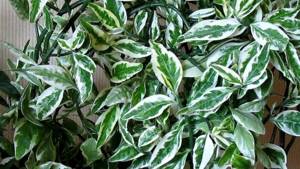
It is better to keep small children and animals away from the potty. Getting the juice into the digestive tract guarantees poisoning.
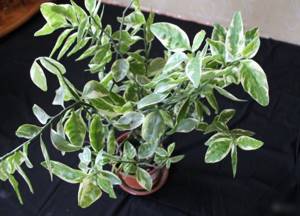
There are also signs and superstitions associated with it, which say that if a flower withers or changes color to dark, this promises illness or negative changes in the fate of the owners, as well as possible quick separations, so it’s worth paying attention to. According to Feng Shui, place it in the living room on the east side.
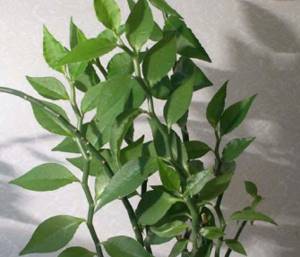
In order to fully familiarize yourself with the rules for keeping this plant, you should watch a video dedicated to this topic and fully revealing the specifics.

